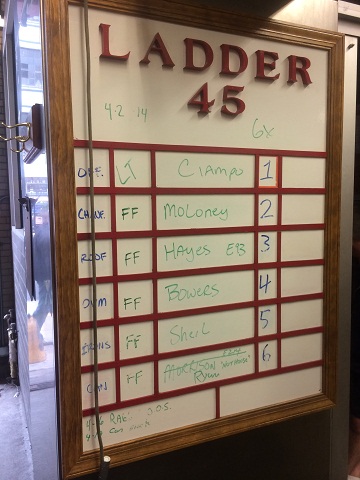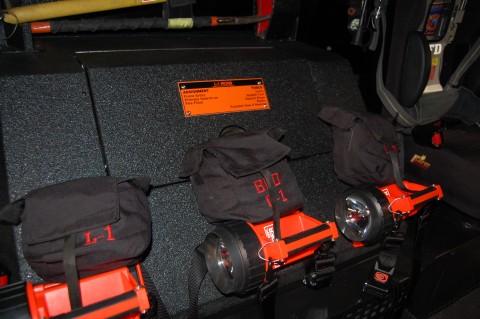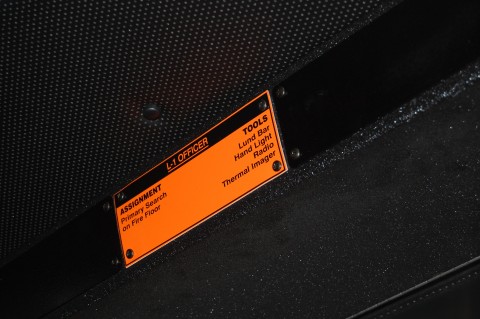Riding assignments are one of the simplest methods to increase your efficiency and effectiveness on the fireground. Riding assignments should be thought-out ahead of time, put in writing, trained on, used on every incident and on every apparatus. The utilization of riding assignments ensures that critical tasks are getting done in the most efficient way, at the most appropriate times, and helps minimize redundancy of efforts. In order to make riding assignments truly effective for your organization, they need to be customized for your specific needs (apparatus, staffing, equipment, building construction, response time, etc.)
Posting the riding assignments in a conspicuous place is helpful to remind everyone who’s assigned to each task, and even helps ensure that the assignments will be actually be used on the fireground.
Pictured above is the riding assignment board for FDNY truck 45. It is a simple whiteboard (done up with some company pride) that list each assignment, and who is assigned for the tour.
Pictured above are examples of apparatus mounted riding assignment placards. (The photos are from Bedford (VA) Ladder 1, the photos were taken a few years ago when the rig was on display at FDIC.) Mounting them on the apparatus, at the actual seat, is an excellent way for Volunteer departments in particular to utilize seat assignments. It reminds each member of their responsibilities since they may end up in different seats, or on different apparatus for each call. Another benefit is that the Officer can quickly look back while enroute and see how many members are on board, and what assignments will be covered, and more importantly what assignments still need to be considered.
In our next post we’ll get into the specifics of some riding assignments, and continue the discussion on their benefit. We will even get into the importance of tool storage as it relates to riding assignments.




Tool storage with respects to riding position and assignment is key. It’s frustrating working on a piece where the tools I’m likely to need aren’t easily at hand. Or worse yet when pair tools (exp- irons and hydra-ram) aren’t stored together.
Does anyone have a copy of their departments seating assignments. For a crew of 3 or 4. I am trying to do some research and getting different perspectives of this.
@Mike
Here is the link to three of our recent riding assignment post. You will find the list of assignments as well as tools carried. Hope this helps!
http://www.vententersearch.com/index.php?s=riding+&sbutt=Go
I believe that riding assignments are setting our members up for failure. Ride assignments tell personnel what to do, and what to bring. This is turning our members into robots instead of thinking firefighters. In the picture above, it tells the ladder company officer what his tool assignment is, and that he is to do a primary search on the fire floor. So, what if the first in engine has knocked the fire and is now doing a primary search? What if the first in engine needs ventilation instead of a primary? What if getting a back up line in position is what is needed at that moment? This is where ride assignments create havoc. The tool assignment for primary search is going to be different than for ventilation. My responsibilities as the first in engine officer are different than the second and third due officer. And, unless you have an arsonist assigned to your company, you don’t know what district the fire will be in. So do we have 15 different riding assignments for the different tasks that company may be assigned to do? If the engine needs ventilation, but your predetermined assignment is primary, what do you do? Do you violate protocol and vent? Or do you let the engine guys take a beating because that isn’t your job today? Yes, a brand new rookie needs to be told exactly what to do, and what to bring with him. But if you have developed your personnel properly, you won’t have to dictate what tools and job functions they are predetermined to do. Lay out basic expectations for your personnel, and let them make decisions based upon conditions and the situation on what tools they should bring with them. But hold them accountable for their decisions. If you are assigned to the roof and your senior guy brings a closet hook and a shovel, he’s going to have to justify his actions. But if you allow your personnel to make decisions, as long as they are using common sense, then you are developing them to be future leaders. Riding assignments are teaching them to be automatons.
I see where you’re coming from Barry, but I see it differently. All fires are different, but we do nearly the same things at all fires. Yes, there are dynamic factors as mentioned above (apparatus, staffing, order of arrival, building construction, etc.), but I view riding assignments as a great starting point; a default playbook if you will. As the first-due truck, “Here’s what we’re gonna do.” I also really like it from a consistency perspective. You have to admit; the opportunity increases for bad stuff to happen when this shift does this and those guys do that. If every single thing has to be decided and assigned right now, think about the impact. In sports, certain players have specific assignments as a default (the rule). When something unique comes up, they call an audible and make necessary adjustments (the exception). For you to say “Riding assignments are teaching them to be automatons is like me saying not having riding assignments is teaching them freelancing. That wouldn’t be true, would it? Do what works best for your department, but c’mon bro, don’t knock something that works for a lot of departments just because it doesn’t work for yours…